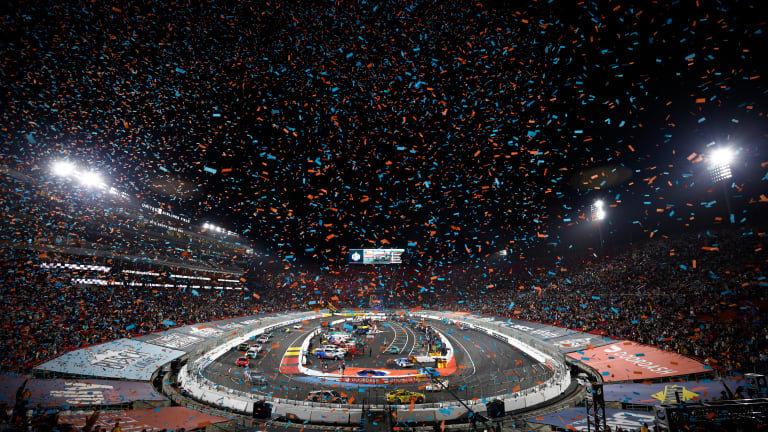
Breaking It Down: The Busch Light Clash

This past weekend, the Busch Light Clash at the Los Angeles Memorial Coliseum kicked off NASCAR’s momentous diamond anniversary in historic fashion with one of the most memorable exhibitions the sport has seen in its 75-year history.
Unlike last year’s inaugural event at the Coliseum, Sunday’s race did not stand out for a fresh concept. Rather, it turned heads and left a lasting impression for the improvements it showed and the unique experience it provided, which instilled critical trust in NASCAR’s newfound willingness to think outside of the box.
When NASCAR first announced the decision to move the Clash from Daytona to the legendary Coliseum, the ambitious concept was met with mixed reviews. Traditionalists felt uneasy about tampering with such a staple on the schedule, and purists doubted the feasibility of packing so many stock cars into a football stadium. While many kept an open mind to the idea, the pressure was on for NASCAR to prove to its fans that the concept could work.
Although last year’s event checked most of the boxes necessary to be considered a success, the second iteration went bigger and better in all of the right ways. For starters, holding the race under the lights of a crisp Los Angeles night built upon the already notable spectacle that came with racing at such a historic venue.
When factored in with a heartier list of celebrity attendees and a halftime show from well-known rapper, Wiz Khalifa, the race provided an entertainment value that most major all-star games fail to achieve in today’s day and age.
In terms of competition, the difference was night and day as well. With the Gen 7 car now having a season under its belt and the parts shortage that weighed heavily on teams last winter largely in the rearview, fans saw far more authentic racing. Drivers were willing to shoot for tight gaps and lay a bumper on the cars in front of them to muscle their way through for a pass.
That type of aggression is nearly unprecedented at the high speeds of standard NASCAR circuits, but at the Coliseum on Sunday night, it made for a classic short-track racing style that tied in NASCAR’s roots in a setting that symbolized its evolution.
As enjoyable as the race was for fans, the drivers found the tight racing to be quite frustrating.
“This is fun. We are having fun.” said Christopher Bell, his tone oozing with sarcasm after getting turned in a heat race.
Other drivers took their emotions more serious, as last year's winner, Joey Logano, and Kyle Busch reignited a rivalry when the defending 2022 Cup champion turned Busch in the main event, which led Busch to call him “two-faced” in his post-race interviews.
With 16 cautions throughout the race (compared to just five cautions in last year's race), tempers were understandably short. But when all was said and done, most drivers seemed willing to embrace the event for the growth it offered the sport and elected to leave their tempers at the track.
There was a lot riding on this year to prove whether or not the concept could find a home in NASCAR’s schedule. Given the improvement in entertainment, production value, magnitude, and on-track action, it’s fair to say this year’s Clash at the Coliseum delivered in every area that fans needed it to.
Everything pales in comparison to the concept of perfection, and with big undertakings such as this event, it is important to remember that it takes trial and error before greatness can truly be sustained,
All in all, Sunday’s second iteration of the Busch Light Clash at the Coliseum showed NASCAR’s ability to grow and adapt with the changing world. For years, the Clash has marked the end of the long offseason hibernation by providing a low-stakes reintroduction to familiar faces in fresh firesuits, the gritty roar of engines, and the fragrance of burning rubber that makes fans feel so at home with the sport.
This time around, however, Sunday’s event built upon this timeless concept by feeding into the future and providing a glimpse of what’s to come from NASCAR’s evolution as a form of entertainment for the modern consumer.
The sport needs breaths of fresh air like the Clash to chaperone NASCAR into attracting the next generation of race fans. With other ambitious undertakings like the Chicago Street Course and North Wilkesboro on the slate for this year, NASCAR is showing that it is willing to roll the dice and challenge tradition. But most importantly, the Clash is a sign that NASCAR is willing to see its bold moves through.
It is one thing for a company to try flashy ideas in hopes of netting eyeballs through the concept, a practice that many fans first accused the company of doing amidst the earliest iterations of big ideas. Yet as we enter the 8th year of the revised playoffs, a third year of Bristol Dirt, and a checkered flag on the series’ second Clash at the Coliseum, it is becoming abundantly clear that NASCAR president Steve Phelps and Co. are not out to sell cheap tricks.
Rather, they have an ambitious, strategic plan in place that they are willing to see through until the end. Make what you will of the change, but the time has come to ease up on the critical eye that NASCAR has been under for years and trust the company’s leadership in its efforts to grow the sport.